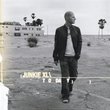| All Artists: Tomasz Stanko Title: From the Green Hill (Reis) Members Wishing: 6 Total Copies: 0 Label: ECM Records Original Release Date: 1/1/2000 Re-Release Date: 5/16/2000 Genres: International Music, Jazz, Special Interest, Pop Styles: Europe, Eastern Europe, Avant Garde & Free Jazz Number of Discs: 1 SwapaCD Credits: 1 UPCs: 731454733625, 0731454733625 |
Search - Tomasz Stanko :: From the Green Hill (Reis)
 | Tomasz Stanko From the Green Hill (Reis) Genres: International Music, Jazz, Special Interest, Pop
Polish trumpeter Tomasz Stanko has plotted something of a musical world tour on From the Green Hill, a polyglot of styles rooted in different folk and traditional forms colliding and commingling over a bedrock of collectiv... more » |
Larger Image |
CD DetailsSynopsis
Amazon.com Polish trumpeter Tomasz Stanko has plotted something of a musical world tour on From the Green Hill, a polyglot of styles rooted in different folk and traditional forms colliding and commingling over a bedrock of collective improvisations. Stanko's music is surely jazz, if the genre's defined as an international language and no longer simply an American art form--clearly rooted in American traditions, but a flexible flyer capable of transcending borders and incorporating the vocabulary and traditions of the musicians who create it. In that broader vein, From the Green Hill is a varied and satisfying recital, which clearly reflects the aesthetic of producer Manfred Eicher, who has been encouraging the development of post-modernist folk music and idiomatic European jazz inventions since the early 1970s. Stanko's dark, burnished sound brings to mind both Rex Stewart and Lester Bowie, as he favors broad, vocalized inflections and an expressive vocabulary of bends, growls, whinnies, and shouts. Yet, as his whimsical lead over the fat, lilting groove of bassist Anders Jormin and the airy, percussive accents and crystalline cymbal phrases of drummer Jon Christensen on "Pantronic" demonstrate, Stanko's is a decidedly lyrical approach. You can hear it on the lightly swinging "Love Theme from Farewell to Maria," as saxophonist John Surman's furry baritone italicizes Stanko's pungent phrasing. Elsewhere, the violin of Michelle Makarski and the bandoneon of Dino Saluzzi offer savory overtones from Warsaw, Paris, and Buenos Aires. --Chip Stern Similarly Requested CDs
|
CD ReviewsRich, fresh and beautiful suspectre | Minneapolis | 08/06/2001 (5 out of 5 stars) "I played this disk for a friend and fellow jazz fan - we both lament the backward-looking nature of contemporary American jazz - and he turned to me, after a moment of awe following Stone Ridge, and wondered aloud if Wynton Marsalis has heard this music. And if he has, what does he think? We both concluded that Marsalis ought to be thinking, "Stanko is kicking my butt." Not that Stanko is a better trumpeter, Marsalis is a brilliant player, but it's just that Stanko is forging ahead creatively, mining the available techniques, music and talent to make astonishing art. Meanwhile, Marsalis and other American talents like Joshua Redman, Wallace Roney etc. seem to be wishing it were 1958 all over again. Just go to the list of latest Jazz releases and you'll find half or more are retrospectives. And if they're not looking back in time they're riding the coattails of hip-hop. Stanko's "From the Green Hill" proves to me that Jazz isn't an antique; there's still quality work to be done that's fresh and interesting." An elegant fusion N. Dorward | Toronto, ON Canada | 09/09/2000 (5 out of 5 stars) "This disc follows the pattern of much of ECM's recent output in deploying a carefully assembled band in a highly democratic manner, often breaking it down to smaller groupings for a series of short tracks; the album features the leader, the Polish trumpeter Tomasz Stanko, only slightly more prominently than the other musicians. Stanko is about as far from ECM's other favourite trumpeter, Kenny Wheeler, as you can get--he has a passionate, vocalized, rough sound that is like no one else's in the music except perhaps occasionally Dave Douglas. He's in the past managed to fit into contexts running from straightahead jazz to folk musics to electronica to the band of Cecil Taylor (the superlative _Winged Serpent, Sliding Quadrants_).On this album he's joined by John Surman on baritone & bass clarinet, Dino Saluzzi on bandoneon, Michelle Makarski on violin (an excellent player I've never heard before, though sadly she only appears on a few tracks), & the expert European rhythm section of Anders Jormin on bass & Jon Christensen on drums. The music is lively & atmospheric--Surman is in ebullient mood (much more so than on some of his own albums like _The Road to St. Ives_), & the bassist & drummer are endlessly inventive. The dynamic range here is exceedingly wide, which I wasn't expecting for an ECM disc--the bandoneon will let things settle into a melancholy & reflective mood, & then Stanko will let 'er rip or Christensen will boot things along.This disc manages to be both beautiful & sharply intelligent. One might especially point fans of Dave Douglas's forays into European folk & classical musics in the direction of this disc, but I'd imagine that anyone interested in good contemporary jazz will enjoy it. Listeners might also check out some of Stanko's work with Bobo Stenson, Jormin & the British drummer Tony Oxley--they've released a number of discs on GOWI & ECM." Vintage Guitar Magazine Review: VG | USA | 06/16/2000 (5 out of 5 stars) "This new release by Polish trumpeter Tomasz Stanko will likely be stocked in the Jazz section of most record shops, but that categorization does not begin to describe the majestic music on this astonishing album. Stanko has joined forces with a who's-who of international avant garde jazz and classical musicians to create this sonic painting. His co-conspirators include master Argentine bandoneonist Dino Saluzzi, violinist Michelle Makarski from Detroit, Swedish double-bassist Anders Jormin, Norwegian drummer Jon Christensen, and Englishman John Surman on baritone sax and bass clairnet. Who could have ever dreamed up such an eclectic assemblage of instrumentation? Listen to the opening bars of the first song, Surman's "Domino," however, and you will swear that these instruments were made for each other. The tones and timbre of violin, bandoneon, and bass clarinet are ideally suited to each other, allowing Stanko's trumpet to wind its way in and out of the other sounds with serpentine fluidity. The sextet moves from mournful to joyous at the drop of a hat, evoking colors and moods and emotions with their fine interplay. This is modern jazz at its finest---a blend of traditional jazz, folk music, and classic sounds that breathes with a new life."
|

 Track Listings (14) - Disc #1
Track Listings (14) - Disc #1